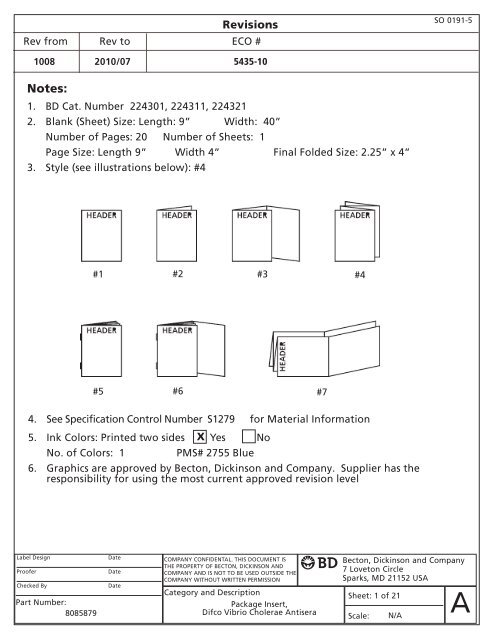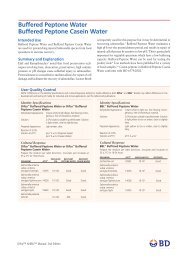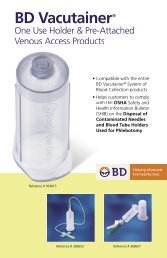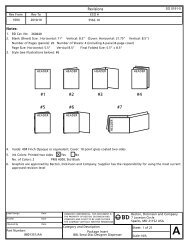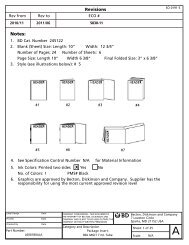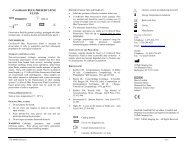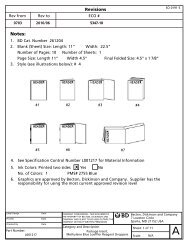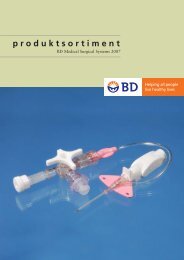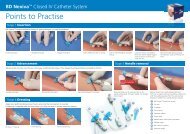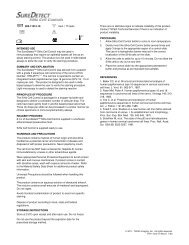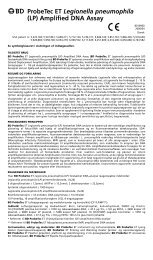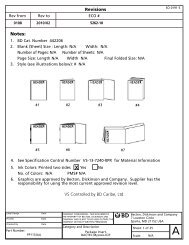Difco Vibrio Cholerae Antisera - BD
Difco Vibrio Cholerae Antisera - BD
Difco Vibrio Cholerae Antisera - BD
You also want an ePaper? Increase the reach of your titles
YUMPU automatically turns print PDFs into web optimized ePapers that Google loves.
Revisions<br />
Rev from Rev to ECO #<br />
1008 2010/07 5435-10<br />
Notes:<br />
1. <strong>BD</strong> Cat. Number 224301, 224311, 224321<br />
2. Blank (Sheet) Size: Length: 9” Width: 40”<br />
Number of Pages: 20 Number of Sheets: 1<br />
Page Size: Length 9” Width 4” Final Folded Size: 2.25” x 4”<br />
3. Style (see illustrations below): #4<br />
#1 #2 #3 #4<br />
#5 #6 #7<br />
4. See Specification Control Number S1279 for Material Information<br />
x<br />
5. Ink Colors: Printed two sides Yes No<br />
No. of Colors: 1 PMS# 2755 Blue<br />
6. Graphics are approved by Becton, Dickinson and Company. Supplier has the<br />
responsibility for using the most current approved revision level<br />
Label Design Date<br />
Proofer Date<br />
Checked By Date<br />
Part Number:<br />
8085879<br />
COMPANY CONFIDENTAL. THIS DOCUMENT IS<br />
THE PROPERTY OF BECTON, DICKINSON AND<br />
COMPANY AND IS NOT TO BE USED OUTSIDE THE<br />
COMPANY WITHOUT WRITTEN PERMISSION<br />
SO 0191-5<br />
Category and Description<br />
Package Insert,<br />
Becton, Dickinson and Company<br />
7 Loveton Circle<br />
Sparks, MD 21152 USA<br />
Sheet: 1 of 21<br />
<strong>Difco</strong> <strong>Vibrio</strong> <strong>Cholerae</strong> <strong>Antisera</strong><br />
Scale: N/A<br />
A
� <strong>Difco</strong> <strong>Vibrio</strong><br />
<strong>Cholerae</strong> <strong>Antisera</strong><br />
English: pages 1 – 4<br />
Français : pages 4 – 7<br />
Deutsch: Seiten 7 – 10<br />
Italiano: pagine 11 – 13<br />
Español: páginas 14 – 17<br />
INTENDED USE<br />
<strong>Difco</strong> <strong>Vibrio</strong> <strong>Cholerae</strong> antisera are recommended for use in slide agglutination tests<br />
for the identification and serotyping of <strong>Vibrio</strong> cholerae.<br />
SUMMARY AND EXPLANATION<br />
V. cholerae is the causative agent of cholera. The spread of the disease is primarily<br />
through contaminated water and the fecal-oral route. If not treated, patients with<br />
severe cholera may die within five hours from massive fluid and electrolyte loss.1<br />
Because <strong>Vibrio</strong> spp. are natural inhabitants of aquatic environments, food products,<br />
such as uncooked seafoods or seafoods incorrectly handled, can spread infection.<br />
Gastrointestinal symptoms of cholera include "rice water stools" caused by a potent<br />
enterotoxin. From humans, the primary specimen is feces. Seafood products are<br />
frequently tested as vehicles of human infection.<br />
Gardner and Ventkatraman2 defined the identification of <strong>Vibrio</strong> cholerae as the<br />
recognition of the somatic antigen O1 (O group 1) as evidenced by agglutination with<br />
O1 (polyvalent) antiserum.<br />
V. cholerae of the O1 serogroup are divided into serotypes: Ogawa, Inaba and<br />
Hikojima.1,3 The antigenic factors are:<br />
Serotype O Antigen Factors<br />
Ogawa AB<br />
Inaba AC<br />
Hikojima ABC<br />
V. cholerae are facultative anaerobes that by microscopic morphology are gramnegative<br />
curved or straight bacilli. The microorganisms either require sodium chloride or<br />
grow best in its presence. Various special media designed to select and cultivate<br />
this microorganism are used in clinical and food microbiology laboratories and for<br />
environmental testing.<br />
PRINCIPLES OF THE PROCEDURE<br />
Identification of V. cholerae includes the isolation of the microorganism, biochemical<br />
identification and serological confirmation.<br />
Serological confirmation involves the reaction in which the microorganism (antigen)<br />
reacts with its corresponding antibody. This in vitro reaction produces macroscopic<br />
clumping called agglutination. The desired homologous reaction is rapid, binds strongly<br />
(high affinity) and does not dissociate (high avidity).<br />
Because a microorganism (antigen) may agglutinate with an antibody produced in<br />
response to some other species, heterologous reactions are possible. These are<br />
characterized as weak in strength and slow in formation. Such unexpected and perhaps<br />
unpredictable reactions may lead to some confusion in serological identification.<br />
Therefore, a positive homologous agglutination reaction should support the<br />
morphological and biochemical identification of the microorganism. Homologous<br />
reactions occur rapidly and are strong. Heterologous reactions form slowly and are weak.<br />
REAGENTS<br />
<strong>Difco</strong> <strong>Vibrio</strong> <strong>Cholerae</strong> antisera are stable, lyophilized polyclonal rabbit <strong>Vibrio</strong> cholerae<br />
O1 antisera containing approximately 0.2% sodium azide as a preservative. <strong>Difco</strong> <strong>Vibrio</strong><br />
<strong>Cholerae</strong> Antiserum Ogawa and <strong>Difco</strong> <strong>Vibrio</strong> <strong>Cholerae</strong> Antiserum Inaba are<br />
monospecific absorbed antisera.<br />
<strong>Difco</strong> <strong>Vibrio</strong> <strong>Cholerae</strong> Antiserum Poly and the absorbed <strong>Difco</strong> <strong>Vibrio</strong> <strong>Cholerae</strong> Antiserum<br />
Ogawa and <strong>Difco</strong> <strong>Vibrio</strong> <strong>Cholerae</strong> Antiserum Inaba contain the following antibodies:<br />
Antiserum O Antibodies<br />
<strong>Difco</strong> <strong>Vibrio</strong> <strong>Cholerae</strong> Antiserum Poly ABC<br />
<strong>Difco</strong> <strong>Vibrio</strong> <strong>Cholerae</strong> Antiserum Ogawa B<br />
�<br />
8085879<br />
2010/07<br />
<strong>Difco</strong> <strong>Vibrio</strong> <strong>Cholerae</strong> Antiserum Inaba C<br />
When reconstituted and used as described, each vial of <strong>Difco</strong> <strong>Vibrio</strong> <strong>Cholerae</strong> antisera<br />
contains sufficient reagent for 20 slide tests.
Warnings and Precautions:<br />
For in vitro Diagnostic Use.<br />
The Packaging of This Product Contains Dry Natural Rubber.<br />
Observe aseptic techniques and established precautions against microbiological hazards<br />
throughout all procedures. After use, specimens, containers, slides, tubes and other contaminated<br />
material must be sterilized by autoclaving. Directions for use should be followed<br />
carefully.<br />
WARNING: This product contains sodium azide. Sodium azide is toxic by inhalation,<br />
by skin contact, and if swallowed. Contact with acid liberates very toxic gas.<br />
After contact with skin, wash immediately with plenty of water. Sodium azide<br />
may react with lead and copper plumbing to form highly explosive metal azides.<br />
On disposal, flush with a large volume of water to prevent azide build-up.<br />
Storage: Store lyophilized and reconstituted <strong>Difco</strong> <strong>Vibrio</strong> <strong>Cholerae</strong> antisera at 2-8°C.<br />
Prolonged exposure of reagents to temperatures other than those specified is<br />
detrimental to the products.<br />
Reconstituted <strong>Difco</strong> <strong>Vibrio</strong> <strong>Cholerae</strong> Antiserum that is cloudy or has a precipitate at any<br />
time during its period of use should be discarded.<br />
Product Deterioration<br />
Expiration date applies to product in its intact container when stored as directed. Do<br />
not use if the product is caked, discolored or shows other signs of deterioration.<br />
SPECIMEN COLLECTION AND PREPARATION<br />
Clinical Specimens:<br />
V. cholerae can be recovered from clinical specimens on selective media, such as TCBS<br />
(thiosulfate-citrate-bile salts-sucrose) agar. For specific recommendations, consult<br />
appropriate references.4-6 Determine that a pure culture of the microorganism has been<br />
obtained and that biochemical test reactions are consistent with the identification of<br />
the organism as V. cholerae. After these criteria are met, serological identification can<br />
be performed.<br />
Food Specimens:<br />
V. cholerae can be recovered from various types of foods, particularly seafood, when<br />
samples are processed to prevent overgrowth of competing microorganisms and<br />
selective media are used to enhance the growth of the microorganism. Some isolation<br />
media have been specifically developed for the food industry. Consult appropriate<br />
references for recommended procedures when testing food samples.7,8 After following<br />
an established protocol, determine that a pure culture of the microorganism has been<br />
obtained and that biochemical test reactions are consistent with the identification of<br />
the organism as V. cholerae. After these criteria are met, the serologic identification can<br />
be performed.<br />
The isolate for serological testing should be subcultured from selective media to a<br />
nonselective agar, such as Nutrient Agar.<br />
PROCEDURE<br />
Materials Provided: <strong>Difco</strong> <strong>Vibrio</strong> <strong>Cholerae</strong> Antiserum Poly, <strong>Difco</strong> <strong>Vibrio</strong> <strong>Cholerae</strong><br />
Antiserum Ogawa and <strong>Difco</strong> <strong>Vibrio</strong> <strong>Cholerae</strong> Antiserum Inaba.<br />
Materials Required But Not Provided: Agglutination slides, applicator sticks and sterile<br />
0.85% saline.<br />
Reconstitution/Reagent Preparation:<br />
Equilibrate all materials to room temperature before performing the tests. Ensure that<br />
all glassware and pipettes are clean and free of residues, such as detergents.<br />
To reconstitute <strong>Difco</strong> <strong>Vibrio</strong> <strong>Cholerae</strong> antiserum add 3 mL of sterile 0.85% saline and<br />
rotate gently to completely dissolve the contents.<br />
Test isolate for autoagglutination:<br />
1. From the test culture on nonselective media, transfer a loopful of growth to a drop<br />
(approximately 35 µL) of sterile 0.85% saline on a clean slide and emulsify the<br />
organism.<br />
2. Rotate the slide for 1 min, then observe for agglutination.<br />
3. If agglutination (autoagglutination) occurs, the culture is rough and cannot be<br />
tested. Subculture to nonselective agar, incubate and test the organism again as<br />
described in steps 1 and 2.<br />
4. If no agglutination occurs, proceed with testing the organism.<br />
Test Procedure<br />
Use the <strong>Difco</strong> <strong>Vibrio</strong> <strong>Cholerae</strong> Antiserum Poly to screen possible V. cholerae isolates.<br />
Continue testing with <strong>Difco</strong> <strong>Vibrio</strong> <strong>Cholerae</strong> Antiserum Ogawa and <strong>Difco</strong> <strong>Vibrio</strong><br />
<strong>Cholerae</strong> Antiserum Inaba.<br />
1. Dispense a drop of the <strong>Difco</strong> <strong>Vibrio</strong> <strong>Cholerae</strong> Antiserum to be tested on an<br />
agglutination slide.<br />
2. Transfer a loopful of growth of the test organism to the drop of antiserum and mix<br />
thoroughly.<br />
3. Rotate the slide for 1 min and read for agglutination.<br />
User Quality Control<br />
At the time of use, test both positive and negative antigen controls to check<br />
performance of the antisera, techniques and methodology.<br />
Quality control requirements must be performed in accordance with applicable local,<br />
state and/or federal regulations or accreditation requirements and your laboratory's<br />
standard Quality Control procedures. It is recommended that the user refer to pertinent<br />
2
CLSI (formerly NCCLS) guidance and CLIA regulations for appropriate Quality Control<br />
practices.<br />
RESULTS<br />
1. Read and record results as follows:<br />
4+ 100% agglutination; background is clear to slightly hazy<br />
3+ 75% agglutination; background is slightly cloudy<br />
2+ 50% agglutination; background is moderately cloudy<br />
1+ 25% agglutination; background is cloudy<br />
– No agglutination<br />
2. The positive control should show 3+ or greater agglutination.<br />
3. The negative control should show no agglutination.<br />
4. For the test isolates, a 3+ or greater agglutination within 1 min is a positive result.<br />
INTERPRETATION OF RESULTS<br />
1. Positive agglutination using <strong>Difco</strong> <strong>Vibrio</strong> <strong>Cholerae</strong> Antiserum Poly with typical<br />
biochemical test results gives presumptive identification of V. cholerae O1.<br />
2. Cultures with positive agglutination in <strong>Difco</strong> <strong>Vibrio</strong> <strong>Cholerae</strong> Antiserum Poly may be<br />
serotyped using the <strong>Difco</strong> <strong>Vibrio</strong> <strong>Cholerae</strong> Antiserum Ogawa and <strong>Difco</strong> <strong>Vibrio</strong><br />
<strong>Cholerae</strong> Antiserum Inaba. Positive agglutination in both antisera is rare and, when<br />
it occurs, is usually interpreted as identifying V. cholerae serotype Hikojima.9<br />
V. cholerae serotype Hikojima is a rare serotype and should be sent to a reference<br />
laboratory for further study.<br />
3. Positive agglutination will be immediate and strong. The strongest and most<br />
rapid reaction should be used to identify the serotype, because V. cholerae O1<br />
strains frequently cross-react slowly or weakly in monospecific antiserum for the<br />
other serotype.<br />
4. Isolates that weakly or slowly agglutinate with <strong>Difco</strong> <strong>Vibrio</strong> <strong>Cholerae</strong> Antiserum<br />
Poly and not with <strong>Difco</strong> <strong>Vibrio</strong> <strong>Cholerae</strong> Antiserum Inaba or <strong>Difco</strong> <strong>Vibrio</strong> <strong>Cholerae</strong><br />
Antiserum Ogawa are usually considered V. cholerae non-O1. The isolate may be<br />
sent to a reference laboratory for further study.<br />
LIMITATIONS OF THE PROCEDURE<br />
1. Correct interpretation of serological reactions depends upon culture purity,<br />
morphological characteristics and biochemical reactions that are consistent with<br />
identification of the microorganism as V. cholerae.<br />
2. Serologic methods alone cannot identify the isolate as V. cholerae.<br />
3. Excessive heat from external sources (hot bacteriological loop, burner flame, light<br />
source, etc.) may prevent a smooth suspension of the microorganism or cause<br />
evaporation or precipitation of the test mixture. False positive reactions may occur.<br />
4. Rough culture isolates do occur and will agglutinate spontaneously causing<br />
agglutination of the negative control (autoagglutination). Smooth colonies must be<br />
selected and tested in serological procedures.<br />
5. <strong>Difco</strong> <strong>Vibrio</strong> <strong>Cholerae</strong> antisera have been tested using undiluted cultures taken from<br />
agar media. These antisera have not been tested using antigen suspensions in saline<br />
or other diluents. If the user applies variations in the recommended steps each lot<br />
of antiserum must be tested with known control cultures to verify expected<br />
reactions under the modified procedure.<br />
6. Reconstituted <strong>Difco</strong> <strong>Vibrio</strong> <strong>Cholerae</strong> Antiserum that is cloudy or has a precipitate at<br />
any time during its period of use should be discarded.<br />
PERFORMANCE CHARACTERISTICS<br />
Sensitivity of <strong>Difco</strong> <strong>Vibrio</strong> <strong>Cholerae</strong> antisera is determined by demonstrating<br />
appropriate reactivity, as defined in the “Results” section, against a battery of wellcharacterized<br />
homologous <strong>Vibrio</strong> cholerae cultures with known antigenic reactivity<br />
(refer to the table below). Specificity is determined by demonstrating non-reactivity<br />
against non-related (heterologous) <strong>Vibrio</strong> cholerae cultures.<br />
Cat. No. Product Homologous Cultures Tested<br />
224321<br />
224311<br />
224301<br />
<strong>Vibrio</strong> <strong>Cholerae</strong><br />
Antiserum Poly<br />
<strong>Vibrio</strong> <strong>Cholerae</strong><br />
Antiserum Ogawa<br />
<strong>Vibrio</strong> <strong>Cholerae</strong><br />
Antiserum Inaba<br />
3<br />
Hikojima 18<br />
Hikojima 18ss<br />
Ogawa Bu93<br />
Ogawa 1321 CDC<br />
Ogawa 20-A-11<br />
Ogawa 11 CDC<br />
Ogawa VRL 628<br />
Inaba 6<br />
Inaba 11 CDC<br />
Inaba 35 A3NIH<br />
Inaba 6 CDC<br />
Ogawa Bu93<br />
Ogawa 1321 CDC<br />
Ogawa 20-A-11<br />
Ogawa 11 CDC<br />
Ogawa VRL 628<br />
Inaba 6<br />
Inaba 11 CDC<br />
Inaba 35 A3NIH<br />
Inaba 6 CDC
AVAILABILITY<br />
Cat. No. Description<br />
224321 <strong>Difco</strong> <strong>Vibrio</strong> <strong>Cholerae</strong> Antiserum Poly, 3 mL<br />
224311 <strong>Difco</strong> <strong>Vibrio</strong> <strong>Cholerae</strong> Antiserum Ogawa, 3 mL<br />
224301 <strong>Difco</strong> <strong>Vibrio</strong> <strong>Cholerae</strong> Antiserum Inaba, 3 mL<br />
REFERENCES<br />
1. World Health Organization. 2001. Weekly Epidemiol. Record. 76: 117-124.<br />
2. Gardner, A.D., and K.V. Venkatraman. 1935. The antigen of the cholera group of<br />
vibrios. J. Hyg. 35:262-282.<br />
3. Nobechi, K. 1923. Contributions to the knowledge of V. cholerae. 3. Immunological<br />
studies upon the types of V cholerae. Sci. Repr. Govt. Inst. Infect. Dis. 2:43-87.<br />
4. Farmer III, J.J., J.M. Janda and K. Birkhead. 2003. <strong>Vibrio</strong>, p. 706-718. In P.R. Murray,<br />
E.J. Barron, J.H. Jorgensen, M.A. Pfaller and R.H. Yolken (ed.), Manual of clinical<br />
microbiology, 8th ed. American Society for Microbiology, Washington, D.C.<br />
5. Pezzlo, M. 1992. Aerobic bacteriology, p.1.0.1-1.20.47. In H. D. Isenberg (ed.),<br />
Clinical microbiology procedures handbook, vol. 1. American Society for<br />
Microbiology, Washington, D.C.<br />
6. Forbes, B.A., D.F. Sahm, A.S Weissfeld and E.A. Trevino. 2002. Bailey & Scott’s<br />
diagnostic microbiology, 11th ed. Mosby, Inc., St. Louis, Mo.<br />
7. Kaysner, C.A., and A. DePaola, Jr. 2001. <strong>Vibrio</strong>, p. 405-420. In F.P Downes and<br />
K. Ito (ed.), Compendium of methods for the microbiological examination of foods,<br />
4th ed. American Public Health Association, Washington, D.C.<br />
8. AOAC International. 2001. FDA bacteriological analytical manual online.<br />
.<br />
9. Kelly, M.T., F.W. Hickman-Brenner and J.J Farmer III. 1991. <strong>Vibrio</strong>, p. 384-395.<br />
In A. Ballows, W.J. Hausler, Jr., K.L. Herrmann, H.D. Isenberg and H.J. Shadomy (ed.),<br />
Manual of clinical microbiology, 5th ed. American Society of Microbiology,<br />
Washington, D.C.<br />
�<strong>Difco</strong><br />
<strong>Vibrio</strong><br />
<strong>Cholerae</strong> <strong>Antisera</strong><br />
APPLICATION<br />
Les <strong>Difco</strong> <strong>Vibrio</strong> <strong>Cholerae</strong> <strong>Antisera</strong> (sérums anti-<strong>Vibrio</strong> cholerae <strong>Difco</strong>) sont recommandés<br />
pour réaliser les tests d'agglutination sur lame servant à l'identification et au sérotypage<br />
de <strong>Vibrio</strong> cholerae.<br />
RESUME ET EXPLICATION<br />
V. cholerae est l'agent pathogène du choléra. La contagion s'effectue principalement<br />
par l'absorption d'eau contaminée et la voie oro-fécale. En l'absence de traitement, un<br />
patient atteint d'une forme grave du choléra peut décéder dans les cinq heures à la<br />
suite de pertes massives d'électrolytes et de liquides biologiques. 1 Comme<br />
l'environnement aquatique constitue l'habitat naturel de <strong>Vibrio</strong> spp., les produits<br />
alimentaires, parmi lesquels les poissons et fruits de mer crus ou avariés, peuvent<br />
transmettre l'infection.<br />
Les symptômes gastro-intestinaux du choléra sont notamment des selles liquides,<br />
afécales, ayant l'aspect « d'eau de riz » provoquées par une puissante entérotoxine.<br />
Chez l'homme, le principal échantillon est constitué par les fèces. Les poissons et fruits<br />
de mer sont fréquemment testés comme vecteurs d'infection potentiels chez l'homme.<br />
Gardner et Ventkatraman2 ont défini l'identification de <strong>Vibrio</strong> cholerae comme la<br />
reconnaissance de l'antigène somatique O1 (O groupe 1) démontrée par l'agglutination<br />
observée avec l'antisérum O1 (polyvalent).<br />
Les V. cholerae appartenant au sérogroupe O1 se répartissent en plusieurs sérotypes :<br />
Ogawa, Inaba et Hikojima. 1,3 Les facteurs antigéniques sont :<br />
Sérotype Facteurs antigène O<br />
Ogawa AB<br />
Inaba AC<br />
Hikojima ABC<br />
Les V. cholerae sont des anaérobies facultatifs se présentant à l'analyse histologique<br />
sous forme de bacilles droits ou courbes à Gram négatif. Leur croissance est facilitée<br />
voire conditionnée par la présence de chlorure de sodium. Différents milieux spéciaux,<br />
conçus pour sélectionner et cultiver ce microorganisme, sont utilisés par les laboratoires<br />
de microbiologie alimentaire et clinique, et lors de tests de contrôle de l'environnement.<br />
PRINCIPES DE LA METHODE<br />
L'identification de V. cholerae comprend l'isolement du microorganisme, son<br />
identification biochimique et sa confirmation sérologique.<br />
La confirmation sérologique implique une réaction dans laquelle un antigène du<br />
microorganisme réagit avec l'anticorps correspondant. Cette réaction in vitro entraîne<br />
une formation d'agrégats macroscopiques appelée agglutination. La réaction<br />
homologue souhaitée est rapide, ne dissocie pas (avidité élevée) et lie fermement<br />
(affinité élevée).<br />
4<br />
Français
Comme l'antigène du microorganisme peut agglutiner un anticorps produit en réponse<br />
à une infection par d'autres espèces bactériennes, des réactions hétérologues sont<br />
possibles. Elles se caractérisent par une concentration faible et de formation lente. Ces<br />
réactions inattendues et éventuellement imprévisibles peuvent conduire à une<br />
identification sérologique imprécise. Ainsi, une réaction d'agglutination homologue<br />
positive doit concorder avec l'identification du microorganisme sur la base de ses<br />
caractéristiques biochimiques et morphologiques. Les réactions homologues se<br />
produisent rapidement et sont fortes. Les réactions hétérologues se forment lentement<br />
et sont faibles.<br />
REACTIFS<br />
Les <strong>Difco</strong> <strong>Vibrio</strong> <strong>Cholerae</strong> <strong>Antisera</strong> sont des antisérums de lapin polyclonales stables<br />
et lyophilisées de <strong>Vibrio</strong> cholerae O1, contenant environ 0,2 % d'azide de sodium<br />
(conservateur). Le <strong>Difco</strong> <strong>Vibrio</strong> <strong>Cholerae</strong> Antiserum Ogawa et le <strong>Difco</strong> <strong>Vibrio</strong> <strong>Cholerae</strong><br />
Antiserum Inaba sont des antisérums rendus monospécifiques par absorption.<br />
Le <strong>Difco</strong> <strong>Vibrio</strong> <strong>Cholerae</strong> Antiserum Ogawa, et le <strong>Difco</strong> <strong>Vibrio</strong> <strong>Cholerae</strong> Antiserum Inaba<br />
rendus monospécifiques par absortion, ainsi que le <strong>Difco</strong> <strong>Vibrio</strong> <strong>Cholerae</strong> Antiserum<br />
possèdent les anticorps suivants :<br />
Antisérum Anticorps anti-O<br />
<strong>Difco</strong> <strong>Vibrio</strong> <strong>Cholerae</strong> Antiserum Poly ABC<br />
<strong>Difco</strong> <strong>Vibrio</strong> <strong>Cholerae</strong> Antiserum Ogawa B<br />
<strong>Difco</strong> <strong>Vibrio</strong> <strong>Cholerae</strong> Antiserum Inaba C<br />
Convenablement reconstitué et utilisé conformément aux instructions, un flacon de<br />
<strong>Difco</strong> <strong>Vibrio</strong> <strong>Cholerae</strong> <strong>Antisera</strong> permet de réaliser 20 tests sur lame.<br />
Avertissements et précautions :<br />
Réservé au diagnostic in vitro.<br />
L'emballage de ce produit contient du caoutchouc naturel sec.<br />
Respecter les techniques d'asepsie et prendre les précautions en vigueur contre les<br />
dangers microbiologiques. Après utilisation, stériliser à l'autoclave les échantillons,<br />
les récipients, les lames, les tubes et tout autre matériel contaminé. Respecter<br />
scrupuleusement le mode d'emploi.<br />
AVERTISSEMENT : Ce produit contient de l'azide de sodium, qui est toxique par inhalation,<br />
contact avec la peau ou ingestion. Au contact d'un acide, un gaz très toxique est<br />
dégagé. Après tout contact avec la peau, laver immédiatement à grande eau. L'azide de<br />
sodium peut réagir au contact du plomb ou du cuivre des canalisations et former des<br />
azides métalliques très explosifs. Lors de l'élimination, faire couler un volume d'eau<br />
important pour éviter l'accumulation d'azides.<br />
Conservation : Conserver les <strong>Difco</strong> <strong>Vibrio</strong> <strong>Cholerae</strong> <strong>Antisera</strong> lyophilisés et reconstitués à<br />
une température comprise entre 2 et 8 °C.<br />
L'exposition prolongée des réactifs à des températures autres que les températures<br />
spécifiées a un effet adverse sur ceux-ci.<br />
Eliminer le <strong>Difco</strong> <strong>Vibrio</strong> <strong>Cholerae</strong> Antiserum reconstitué s'il est trouble ou présente un<br />
précipité, même temporairement, en cours d'utilisation.<br />
Détérioration du produit<br />
La date de péremption s'applique au produit contenu dans son emballage intact et<br />
conservé conformément aux instructions. Ne pas utiliser le produit s'il présente un<br />
aspect agglutiné ou décoloré, ou d'autres signes de détérioration.<br />
PRELEVEMENT ET PREPARATION DES ECHANTILLONS<br />
Echantillons cliniques :<br />
V. cholerae peut être isolé à partir d'échantillons cliniques sur milieux sélectifs comme<br />
la gélose TCBS (thiosulfate-citrate-sels biliaires-saccharose). Consulter les publications<br />
citées en référence pour plus d'informations. 4-6 Vérifier la pureté de la culture et<br />
s'assurer que les résultats des tests biochimiques concordent avec l'identification du<br />
microorganisme comme V. cholerae. Si ces conditions sont remplies, l'identification<br />
sérologique peut être effectuée.<br />
Echantillons alimentaires :<br />
V. cholerae peut être isolé à partir de divers produits alimentaires, notamment les<br />
poissons et fruits de mer, en traitant les échantillons afin d'empêcher une croissance<br />
excessive des microorganismes concurrents et en utilisant des milieux sélectifs pour<br />
favoriser la croissance du microorganisme. Certains milieux d'isolement ont été mis au<br />
point spécialement pour l'industrie alimentaire. Consulter les publications citées en<br />
référence pour connaître les méthodes de test recommandées des échantillons<br />
alimentaires. 7,8 Après avoir suivi un protocole établi, vérifier la pureté de la culture et<br />
s'assurer que les résultats des tests biochimiques concordent avec l'identification du<br />
microorganisme comme V. cholerae. Si ces conditions sont remplies, l'identification<br />
sérologique peut être effectuée.<br />
L'isolat destiné au test sérologique doit être repiqué à partir du milieu sélectif sur<br />
une gélose non sélective telle que la gélose nutritive.<br />
METHODE<br />
Matériaux fournis : <strong>Difco</strong> <strong>Vibrio</strong> <strong>Cholerae</strong> Antiserum Poly, <strong>Difco</strong> <strong>Vibrio</strong> <strong>Cholerae</strong><br />
Antiserum Ogawa et <strong>Difco</strong> <strong>Vibrio</strong> <strong>Cholerae</strong> Antiserum Inaba.<br />
Matériaux requis mais non fournis : Lames à agglutination, écouvillons et sérum<br />
physiologique stérile à 0,85 %.<br />
5
Reconstitution/préparation du réactif :<br />
Laisser le matériel s'équilibrer jusqu'à la température ambiante avant d'effectuer les<br />
tests. S'assurer que la verrerie et les pipettes utilisées sont propres et exemptes de<br />
résidus, comme des traces de détergent.<br />
Pour reconstituer le <strong>Difco</strong> <strong>Vibrio</strong> <strong>Cholerae</strong> Antiserum , ajouter 3 mL de sérum physiologique<br />
stérile à 0,85 % et faire tourner doucement jusqu'à dissolution complète du<br />
contenu.<br />
Test d'autoagglutination de l'isolat :<br />
1. A l'aide d'un ensemenceur, prélever une anse de la culture à analyser sur une boîte<br />
de milieu non sélectif, transférer le contenu dans une goutte (environ 35 µL) de<br />
sérum physiologique stérile à 0,85 % déposé sur une lame propre et mettre en<br />
suspension les microorganismes.<br />
2. Agiter pendant 1 min par un mouvement de rotation de la lame, puis observer s'il<br />
se produit une réaction d'agglutination.<br />
3. Si une agglutination se produit (autoagglutination), la culture n'est pas pure et ne<br />
peut pas être testée. Repquer la culture sur gélose non sélective, incuber et tester<br />
de nouveau le microorganisme comme expliqué aux étapes 1 et 2.<br />
4. En l'absence d'agglutination, procéder au test du microorganisme.<br />
Mode opératoire du test<br />
Utiliser le <strong>Difco</strong> <strong>Vibrio</strong> <strong>Cholerae</strong> Antiserum Poly pour tester les isolats de V. cholerae<br />
présomptifs. Poursuivre le test avec le <strong>Difco</strong> <strong>Vibrio</strong> <strong>Cholerae</strong> Antiserum Ogawa et le<br />
<strong>Difco</strong> <strong>Vibrio</strong> <strong>Cholerae</strong> Antiserum Inaba.<br />
1. Déposer 1 goutte du <strong>Difco</strong> <strong>Vibrio</strong> <strong>Cholerae</strong> Antiserum à tester sur une lame à<br />
agglutination.<br />
2. A l'aide d'un ensemenceur, transférer une pleine anse de culture bactérienne à<br />
analyser dans la goutte d'antisérum et bien mélanger.<br />
3. Agiter pendant 1 min par un mouvement de rotation de la lame, puis observer s'il<br />
se produit une réaction d'agglutination.<br />
Contrôle de qualité par l'utilisateur<br />
Tester dans la même série des antigènes de contrôles positif et négatif pour contrôler les<br />
performances de l'antisérum, des techniques et de la méthodologie.<br />
Effectuer les contrôles de qualité conformément aux réglementations nationales et/ou<br />
internationales, aux exigences des organismes d'homologation concernés et aux<br />
procédures de contrôle de qualité en vigueur dans l'établissement. Il est recommandé à<br />
l'utilisateur de consulter les directives CLSI (anciennement NCCLS) et la réglementation<br />
CLIA concernées pour plus d'informations sur les modalités de contrôle de qualité.<br />
RESULTATS<br />
1. Lire et reporter les résultats comme suit :<br />
4+ 100 % d'agglutination ; fond clair à légèrement voilé<br />
3+ 75 % d'agglutination ; fond légèrement trouble<br />
2+ 50 % d'agglutination ; fond moyennement trouble<br />
1+ 25 % d'agglutination ; fond trouble<br />
– Absence d'agglutination<br />
2. Le contrôle positif doit provoquer une agglutination de niveau 3+ ou supérieur.<br />
3. Le contrôle négatif ne doit présenter aucune agglutination.<br />
4. S'agissant des isolats à tester, une agglutination de niveau 3+ ou supérieur en moins<br />
d'1 min constitue un résultat positif.<br />
INTERPRETATION DES RESULTATS<br />
1. Un résultat d'agglutination positif avec le <strong>Difco</strong> <strong>Vibrio</strong> <strong>Cholerae</strong> Antiserum Poly<br />
associé à des résultats de tests biochimiques concordants constitue une<br />
identification présomptive de V. cholerae O1.<br />
2. Les cultures présentant une agglutination positive avec le <strong>Difco</strong> <strong>Vibrio</strong> <strong>Cholerae</strong><br />
Antiserum Poly peuvent être sérotypés en utilisant le <strong>Difco</strong> <strong>Vibrio</strong> <strong>Cholerae</strong><br />
Antiserum Ogawa et le <strong>Difco</strong> <strong>Vibrio</strong> <strong>Cholerae</strong> Antiserum Inaba. Une agglutination<br />
positive avec les deux types d'antisérums est rarement observée ; elle est alors<br />
habituellement interprétée comme identifiant le sérotype Hikojima de V. cholerae. 9<br />
L'isolat correspondant à ce sérotype rare de V. cholerae doit être envoyé à un<br />
laboratoire de référence pour des analyses complémentaires.<br />
3. Une agglutination positive doit intervenir immédiatement et présenter une forte<br />
affinité. La réaction montrant la plus forte affinité et la vitesse la plus élevée sera<br />
obligatoirement utilisée pour identifier le sérotype, car les souches de V. cholerae<br />
O1 produisent fréquemment une réaction croisée lente ou de faible affinité avec<br />
l'antisérum monospécifique correspondant à l'autre sérotype.<br />
4. Les isolats qui présentent une agglutination faible ou lente avec le <strong>Difco</strong> <strong>Vibrio</strong><br />
<strong>Cholerae</strong> Antiserum Poly sans produire d'agglutination avec le <strong>Difco</strong> <strong>Vibrio</strong> <strong>Cholerae</strong><br />
Antiserum Inaba ou le <strong>Difco</strong> <strong>Vibrio</strong> <strong>Cholerae</strong> Antiserum Ogawa sont habituellement<br />
considérés comme des souches V. cholerae non O1. L'isolat peut être adressé à un<br />
laboratoire de référence pour des analyses complémentaires.<br />
LIMITES DE LA PROCEDURE<br />
1. La pertinence de l'interprétation des réactions sérologiques est fonction de la<br />
pureté de la culture et de la concordance des réactions biochimiques et des<br />
caractéristiques morphologiques identifiant le microorganisme comme V. cholerae.<br />
2. Utilisées seules, les méthodes sérologiques ne suffisent pas à identifier un isolat<br />
comme étant V. cholerae.<br />
3. Une source de chaleur externe excessive (anse d'ensemenceur brûlante, flamme du<br />
bec bunsen, source lumineuse, etc.) peut empêcher d'obtenir une suspension fluide<br />
6
du microorganisme ou entraîner une évaporation ou la précipitation du mélange<br />
réactionnel. Des faux positifs risquent d'être obtenus.<br />
4. Des isolats de culture non purs sont parfois obtenus et provoquent une<br />
agglutination spontanée entraînant l'agglutination du contrôle négatif<br />
(autoagglutination). Choisir des colonies lisses et les tester suivant les<br />
méthodes sérologiques.<br />
5. Les <strong>Difco</strong> <strong>Vibrio</strong> <strong>Cholerae</strong> <strong>Antisera</strong> ont été testés sur des cultures non diluées<br />
prélevées sur milieu gélosé. Ces antisérums n'ont pas été testés sur des suspensions<br />
d'antigène réalisées dans du sérum physiologique ou d'autres diluants.<br />
Si l'utilisateur apporte des variations aux étapes recommandées, chaque lot<br />
d'antisérum doit être testé en utilisant des cultures contrôles connues, afin de<br />
s'assurer que la méthode modifiée permet d'obtenir les résultats escomptés.<br />
6. Eliminer le <strong>Difco</strong> <strong>Vibrio</strong> <strong>Cholerae</strong> Antiserum reconstitué s'il est trouble ou présente<br />
un précipité, même temporairement, en cours d'utilisation.<br />
CARACTERISTIQUES DE PERFORMANCES<br />
La sensibilité des <strong>Difco</strong> <strong>Vibrio</strong> <strong>Cholerae</strong> <strong>Antisera</strong> est déterminée en démontrant une<br />
réactivité conforme, définie dans la section « Résultats », contre une batterie<br />
de cultures homologues bien caractérisées de <strong>Vibrio</strong> cholerae, de réactivité<br />
antigénique connue (consulter le tableau ci-dessous). La spécificité est déterminée en<br />
démontrant une absence de réactivité contre les groupes non-apparentés de <strong>Vibrio</strong><br />
cholerae (hétérologues).<br />
CONDITIONNEMENT<br />
N° réf. Produit Cultures homologues testées<br />
224321<br />
224311<br />
224301<br />
<strong>Vibrio</strong> <strong>Cholerae</strong><br />
Antiserum Poly<br />
<strong>Vibrio</strong> <strong>Cholerae</strong><br />
Antiserum Ogawa<br />
<strong>Vibrio</strong> <strong>Cholerae</strong><br />
Antiserum Inaba<br />
N° réf. Description<br />
224321 <strong>Difco</strong> <strong>Vibrio</strong> <strong>Cholerae</strong> Antiserum Poly, 3 mL<br />
224311 <strong>Difco</strong> <strong>Vibrio</strong> <strong>Cholerae</strong> Antiserum Ogawa, 3 mL<br />
224301 <strong>Difco</strong> <strong>Vibrio</strong> <strong>Cholerae</strong> Antiserum Inaba, 3 mL<br />
REFERENCES : Voir la section « References » dans la notice en anglais.<br />
VERWENDUNGSZWECK<br />
<strong>Difco</strong> <strong>Vibrio</strong> <strong>Cholerae</strong> <strong>Antisera</strong> (<strong>Difco</strong>-<strong>Vibrio</strong> <strong>Cholerae</strong>-Antiseren) werden für<br />
Objektträger-Agglutinationstests zur Identifizierung und Serotypisierung von <strong>Vibrio</strong><br />
cholerae empfohlen.<br />
ZUSAMMENFASSUNG UND ERKLÄRUNG<br />
V. cholerae ist der Erreger der Cholera. Die Ausbreitung dieser Krankheit erfolgt<br />
hauptsächlich durch kontaminiertes Wasser und auf fäkal-oralem Wege. Bei<br />
ausbleibender Behandlung können schwer an Cholera Erkrankte innerhalb von fünf<br />
Stunden infolge massiver Flüssigkeits- und Elektrolytverluste sterben. 1 Da <strong>Vibrio</strong> spp.<br />
natürliche Bewohner von Gewässern sind, kann die Infektion durch Lebensmittel, wie<br />
bspw. rohen oder falsch gehandhabten Fisch, verbreitet werden.<br />
Zu den gastrointestinalen Symptomen von Cholera zählen die durch ein starkes<br />
Enterotoxin ausgelösten sogenannten „Reiswasserstühle”. Die hauptsächliche<br />
Human-Probenart ist Stuhl. Häufig werden Fisch- und Schalentierprodukte als Träger<br />
von Human-Infektionserregern getestet.<br />
Gardner und Ventkatraman2 definierten die Identifizierung von <strong>Vibrio</strong> cholerae als die<br />
Erkennung des Körperantigens O1 (O-Gruppe 1), ersichtlich aus der Agglutination mit<br />
(polyvalentem) O1-Antiserum.<br />
V. cholerae der Serogruppe O1 wird in folgende Serotypen unterteilt: Ogawa, Inaba und<br />
Hikojima. 1,3 Die Antigenfaktoren sind:<br />
7<br />
Hikojima 18<br />
Hikojima 18ss<br />
Ogawa Bu93<br />
Ogawa 1321 CDC<br />
Ogawa 20-A-11<br />
Ogawa 11 CDC<br />
Ogawa VRL 628<br />
Inaba 6<br />
Inaba 11 CDC<br />
Inaba 35 A3NIH<br />
Inaba 6 CDC<br />
Ogawa Bu93<br />
Ogawa 1321 CDC<br />
Ogawa 20-A-11<br />
Ogawa 11 CDC<br />
Ogawa VRL 628<br />
Inaba 6<br />
Inaba 11 CDC<br />
Inaba 35 A3NIH<br />
Inaba 6 CDC<br />
�<strong>Difco</strong><br />
<strong>Vibrio</strong><br />
<strong>Cholerae</strong> <strong>Antisera</strong><br />
Deutsch
Serotyp O-Antigenfaktoren<br />
Ogawa AB<br />
Inaba AC<br />
Hikojima ABC<br />
V. cholerae sind fakultativ anaerobe Organismen, die unter dem Mikroskop die<br />
Morphologie gramnegativer gekrümmter oder gerader Bazillen zeigen. Diese<br />
Mikroorganismen benötigen Natriumchlorid bzw. wachsen in dessen Gegenwart<br />
optimal. In klinischen und Lebensmittel-Mikrobiologielabors sowie beim Testen von<br />
Umweltproben werden verschiedene spezielle Medien für die Selektierung und<br />
Kultivierung dieses Mikroorganismus verwendet.<br />
VERFAHRENSGRUNDLAGEN<br />
Die Identifizierung von V. cholerae umfasst die Isolierung des Mikroorganismus, die<br />
biochemische Identifizierung und die serologische Bestätigung.<br />
Als serologischer Nachweis zählt die Reaktion, bei der der Mikroorganismus (Antigen)<br />
mit dem entsprechenden Antikörper reagiert. Bei dieser In-vitro-Reaktion kommt es zur<br />
makroskopischen Verklumpungen, der sogenannten Agglutination. Die gewünschte<br />
homologe Reaktion sollte rasch, mit starker Bindung (hoher Affinität) und ohne<br />
Dissoziation (hohe Avidität) erfolgen.<br />
Da ein Mikroorganismus (Antigen) auch mit Antikörpern agglutinieren kann, die als<br />
Reaktion auf andere Spezies gebildet wurden, sind heterologe Reaktionen möglich.<br />
Diese zeichnen sich durch einen langsamen und schwachen Reaktionsverlauf aus.<br />
Derartige unerwartete und evtl. unvorhersehbare Reaktionen können bei der<br />
serologischen Identifizierung einige Verwirrung stiften. Daher sollte eine positive<br />
homologe Agglutinationsreaktion die morphologische und biochemische Identifizierung<br />
des Mikroorganismus unterstützen. Homologe Reaktionen laufen schnell und heftig ab.<br />
Heterologe Reaktionen laufen langsam und schwach ab.<br />
REAGENZIEN<br />
<strong>Difco</strong> <strong>Vibrio</strong> <strong>Cholerae</strong> <strong>Antisera</strong> sind stabile, lyophilisierte, polyklonale Kaninchen-<strong>Vibrio</strong><br />
cholerae-O1-Antiseren und enthalten ca. 0,2% Natriumazid als Konservierungsmittel.<br />
Das <strong>Difco</strong> <strong>Vibrio</strong> <strong>Cholerae</strong> Antiserum Ogawa und das <strong>Difco</strong> <strong>Vibrio</strong> <strong>Cholerae</strong> Antiserum<br />
Inaba sind monospezifische absorbierte Antiseren.<br />
Das <strong>Difco</strong> <strong>Vibrio</strong> <strong>Cholerae</strong> Antiserum Poly und das absorbierte <strong>Difco</strong> <strong>Vibrio</strong> <strong>Cholerae</strong><br />
Antiserum Ogawa sowie das absorbierte <strong>Difco</strong> <strong>Vibrio</strong> <strong>Cholerae</strong> Antiserum Inaba<br />
enthalten die folgenden Antikörper:<br />
Antiserum O-Antikörper<br />
<strong>Difco</strong> <strong>Vibrio</strong> <strong>Cholerae</strong> Antiserum Poly ABC<br />
<strong>Difco</strong> <strong>Vibrio</strong> <strong>Cholerae</strong> Antiserum Ogawa B<br />
<strong>Difco</strong> <strong>Vibrio</strong> <strong>Cholerae</strong> Antiserum Inaba C<br />
Bei korrekter Rekonstituierung und vorschriftsmäßiger Anwendung enthält jedes<br />
Fläschchen <strong>Difco</strong> <strong>Vibrio</strong> <strong>Cholerae</strong> Antiserum eine ausreichende Reagenzienmenge für<br />
20 Objektträger-Tests.<br />
Warnungen und Vorsichtsmaßnahmen:<br />
In-vitro-Diagnostikum.<br />
Die Verpackung dieses Produkts enthält Naturkautschuk (getrocknet).<br />
Der Umgang mit mikrobiologischem Material sollte bei allen Verfahren unter<br />
Einhaltung aseptischer Arbeitsweise und der allgemein üblichen Vorsichtsmaßnahmen<br />
erfolgen. Nach Gebrauch sind Proben, Behälter, Objektträger, Röhrchen und sonstiges<br />
kontaminiertes Material im Autoklaven zu sterilisieren. Die Gebrauchsanleitung ist<br />
sorgfältig zu befolgen.<br />
WARNUNG: Dieses Produkt enthält Natriumazid, das beim Einatmen, bei Berührung mit<br />
der Haut und beim Verschlucken sehr giftig ist. Bei Kontakt mit Säure entstehen<br />
hochgiftige Gase. Bei Kontakt mit der Haut sofort mit viel Wasser abwaschen.<br />
Natriumazid kann mit Blei- und Kupferleitungen reagieren und hochexplosive<br />
Metallazide bilden. Beim Entsorgen mit sehr viel Wasser nachspülen, um Ansammlungen<br />
von Azid zu vermeiden.<br />
Aufbewahrung: Lyophilisierte und rekonstituierte <strong>Difco</strong> <strong>Vibrio</strong> <strong>Cholerae</strong> <strong>Antisera</strong> bei<br />
2 - 8 °C aufbewahren.<br />
Werden die Reagenzien längere Zeit anderen Temperaturen ausgesetzt als<br />
vorgeschrieben, ist dies den Produkten abträglich.<br />
Erscheint das rekonstituierte <strong>Difco</strong> <strong>Vibrio</strong> <strong>Cholerae</strong> Antiserum zu irgendeinem Zeitpunkt<br />
während seiner Verwendung wolkig oder weist Ausfällungen auf, ist es zu entsorgen.<br />
Haltbarkeit des Produkts<br />
Das Verfallsdatum gilt für das im unversehrten Behälter aufbewahrte Produkt bei<br />
Einhaltung der Lagervorschriften. Zusammenklebendes, verfärbtes oder sonstige<br />
Verfallsanzeichen aufweisendes Produkt nicht verwenden.<br />
PROBENENTNAHME UND -VORBEREITUNG<br />
Klinische Proben:<br />
V. cholerae kann aus klinischen Proben auf Selektiv-Medien (wie bspw. TCBS [Thiosulfat-<br />
Zitrat-Gallensalz-Saccharose-Agar]) gewonnen werden. Spezifische Empfehlungen sind<br />
der einschlägigen Literatur zu entnehmen. 4-6 Sicherstellen, dass eine Reinkultur des<br />
Mikroorganismus gewonnen wurde und die biochemischen Testreaktionen der<br />
Identifizierung des Organismus als V. cholerae entsprechen. Sind diese Kriterien erfüllt,<br />
kann die serologische Identifizierung durchgeführt werden.<br />
8
Nahrungsmittelproben:<br />
V. cholerae kann aus verschiedenen Lebensmitteln, insbesondere Fisch und<br />
Schalentieren, gewonnen werden, wenn die Proben zur Vermeidung von Überwachsung<br />
durch konkurrierende Mikroorganismen behandelt und Selektiv-Medien zur Förderung<br />
des interessierenden Mikroorganismus-Wachstums verwendet werden. Einige<br />
Isolat-Medien wurden speziell für die Lebensmittelindustrie entwickelt. Empfohlene<br />
Verfahren für das Testen von Nahrungsmittelproben sind der einschlägigen Literatur zu<br />
entnehmen. 7,8 Nach der exakten Durchführung eines anerkannten Protokolls<br />
sicherstellen, dass eine Reinkultur des Mikroorganismus gewonnen wurde und die<br />
biochemischen Testreaktionen der Identifizierung des Organismus als V. cholerae<br />
entsprechen. Sind diese Kriterien erfüllt, kann die serologische Identifizierung<br />
durchgeführt werden.<br />
Isolate für serologische Tests sollten aus Subkulturen des Selektiv-Mediums auf einem<br />
nicht selektiven Agar, wie bspw. einem Nähr-Agar, gewonnen werden.<br />
VERFAHREN<br />
Mitgeliefertes Arbeitsmaterial: <strong>Difco</strong> <strong>Vibrio</strong> <strong>Cholerae</strong> Antiserum Poly, <strong>Difco</strong> <strong>Vibrio</strong><br />
<strong>Cholerae</strong> Antiserum Ogawa und <strong>Difco</strong> <strong>Vibrio</strong> <strong>Cholerae</strong> Antiserum Inaba.<br />
Benötigtes, jedoch nicht mitgeliefertes Arbeitsmaterial: Agglutinations-Objektträger,<br />
Applikatorstäbchen und sterile 0,85%ige Kochsalzlösung.<br />
Rekonstituierung/Vorbereitung der Reagenzien:<br />
Vor der Testdurchführung alle Materialien Raumtemperatur annehmen lassen.<br />
Sicherstellen, dass alle gläsernen Utensilien und Pipetten sauber sind und keine<br />
Rückstände aufweisen (wie z.B. von Reinigungsmitteln).<br />
Zum Rekonstituieren des <strong>Difco</strong> <strong>Vibrio</strong> <strong>Cholerae</strong> Antiserums 3 mL sterile 0,85%ige<br />
Kochsalzlösung zugeben und behutsam drehen, um den Inhalt vollständig zu lösen.<br />
Testen des Isolats im Hinblick auf Autoagglutination:<br />
1. Eine Impföse voll Wachstum von der Testkultur auf nichtselektiven Medien zu einem<br />
Tropfen (ca. 35 µL) steriler 0,85%iger Kochsalzlösung auf einen sauberen<br />
Objektträger transferieren und den Organismus emulgieren.<br />
2. Den Objektträger 1 min lang drehen und anschließend im Hinblick auf<br />
Agglutination begutachten.<br />
3. Falls es zu einer Agglutination (Autoagglutination) kommt, ist die Kultur grob<br />
und nicht zum Testen geeignet. Eine Subkultur auf nichtselektivem Agar anlegen,<br />
inkubieren, und den Organismus erneut testen, wie in den Schritten 1 und 2<br />
beschrieben.<br />
4. Kommt es nicht zu einer Agglutination, mit dem Testen des Organismus fortfahren.<br />
Testverfahren<br />
Das <strong>Difco</strong> <strong>Vibrio</strong> <strong>Cholerae</strong> Antiserum Poly für das Screening auf mögliche V. cholerae-<br />
Isolate verwenden. Den Test mit dem <strong>Difco</strong> <strong>Vibrio</strong> <strong>Cholerae</strong> Antiserum Ogawa und dem<br />
<strong>Difco</strong> <strong>Vibrio</strong> <strong>Cholerae</strong> Antiserum Inaba fortsetzen.<br />
1. Einen Tropfen des zu testenden <strong>Difco</strong> <strong>Vibrio</strong> <strong>Cholerae</strong> Antiserum auf einen<br />
Agglutinations-Objektträger abgeben.<br />
2. Eine Impföse voll Testorganismus-Wachstum zu dem Tropfen Antiserum<br />
transferieren und gut mischen.<br />
3. Den Objektträger 1 min lang drehen und anschließend im Hinblick auf<br />
Agglutination begutachten.<br />
Qualitätssicherung durch den Anwender<br />
Bei der Anwendung sowohl positive als auch negative Antigen-Kontrollen testen, um<br />
die Leistung der Antiseren, die Techniken und die Methodik zu überprüfen.<br />
Es sind die geltenden gesetzlichen und behördlichen und in den<br />
Akkreditierungsbedingungen festgelegten Vorschriften zur Qualitätskontrolle sowie die<br />
laborinternen Standardvorgaben zur Qualitätskontrolle zu beachten. Benutzer sollten<br />
die relevanten CLSI (ehemals NCCLS)-Dokumente und CLIA-Vorschriften über geeignete<br />
Testverfahren zur Qualitätskontrolle einsehen.<br />
ERGEBNISSE<br />
1. Die Ergebnisse werden folgendermaßen abgelesen und dokumentiert:<br />
4+ 100%ige Agglutination; Hintergrund klar bis leicht trüb<br />
3+ 75%ige Agglutination; Hintergrund leicht wolkig<br />
2+ 50%ige Agglutination; Hintergrund mäßig wolkig<br />
1+ 25%ige Agglutination; Hintergrund wolkig<br />
– Keine Agglutination<br />
2. Die positive Kontrolle sollte eine Agglutination des Grades 3+ oder stärker aufweisen.<br />
3. Die negative Kontrolle darf keine Agglutination aufweisen.<br />
4. Bei den Test-Isolaten stellt eine innerhalb 1 min erfolgende Agglutination des<br />
Grades 3+ oder stärker ein positives Ergebnis dar.<br />
INTERPRETATION DER ERGEBNISSE<br />
1. Eine positive Agglutination bei Verwendung von <strong>Difco</strong> <strong>Vibrio</strong> <strong>Cholerae</strong> Antiserum<br />
Poly mit typischen biochemischen Testergebnissen stellt eine präsumtive<br />
Identifizierung von V. cholerae-O1 dar.<br />
2. Bei Kulturen mit positiver Agglutination in <strong>Difco</strong> <strong>Vibrio</strong> <strong>Cholerae</strong> Antiserum Poly<br />
kann der Serotyp unter Verwendung von <strong>Difco</strong> <strong>Vibrio</strong> <strong>Cholerae</strong> Antiserum Ogawa<br />
und <strong>Difco</strong> <strong>Vibrio</strong> <strong>Cholerae</strong> Antiserum Inaba bestimmt werden. Eine positive<br />
Agglutination in beiden Antiseren ist selten. Wenn es dazu kommt, wird dies<br />
gewöhnlich als Identifizierung von V. cholerae des Serotyps Hikojima gewertet. 9<br />
Der V. cholerae-Serotyp Hikojima ist ein seltener Serotyp und sollte zur weiteren<br />
Untersuchung an ein Referenzlabor eingereicht werden.<br />
9
3. Eine positive Agglutination erfolgt sofort und in ausgeprägter Form. Zur<br />
Identifizierung des Serotyps ist die stärkste und schnellste Reaktion heranzuziehen,<br />
da V. cholerae-O1-Stämme im monospezifischen Antiserum des anderen Serotyps<br />
häufig langsame oder schwache Kreuzreaktionen ergeben.<br />
4. Schwach oder langsam mit <strong>Difco</strong> <strong>Vibrio</strong> <strong>Cholerae</strong> Antiserum Poly und nicht mit<br />
<strong>Difco</strong> <strong>Vibrio</strong> <strong>Cholerae</strong> Antiserum Inaba oder <strong>Difco</strong> <strong>Vibrio</strong> <strong>Cholerae</strong> Antiserum<br />
Ogawa agglutinierende Isolate werden gewöhnlich als V. cholerae des Typs<br />
Nicht-O1 eingestuft. Diese Isolate können zur weiteren Untersuchung an ein<br />
Referenzlabor eingereicht werden.<br />
VERFAHRENSBESCHRÄNKUNGEN<br />
1. Eine korrekte Interpretation der serologischen Reaktionen ist abhängig von der<br />
Reinheit der Kultur, morphologischen Eigenschaften und biochemischen<br />
Reaktionen, die der Identifizierung des Mikroorganismus als V. cholerae<br />
entsprechen.<br />
2. Serologische Methoden allein sind nicht ausreichend zur Identifizierung des Isolats<br />
als V. cholerae.<br />
3. Übermäßige Wärme aus externen Quellen (heiße bakteriologische Öse,<br />
Brennerflamme, Lichtquelle u. dgl.) kann die glatte Suspension des<br />
Mikroorganismus verhindern oder zum Verdunsten oder Ausfällen des Testgemischs<br />
führen. Es kann zu falsch positiven Reaktionen kommen.<br />
4. Grobe Kulturisolate können auftreten; sie agglutinieren spontan und führen zur<br />
Agglutination der negative Kontrolle (Autoagglutination). Es sind glatte Kolonien<br />
zu wählen und mit serologischen Verfahren zu testen.<br />
5. Die <strong>Difco</strong> <strong>Vibrio</strong> <strong>Cholerae</strong> <strong>Antisera</strong> wurden unter Verwendung unverdünnter<br />
Kulturen auf Agar-Medien getestet. Diese Antiseren wurden nicht mit<br />
Antigen-Suspensionen in Kochsalzlösung oder sonstigen Verdünnungsmitteln<br />
getestet. Weicht der Anwender von den empfohlenen Schritten ab, ist jede<br />
Antiserum-Charge mit bekannten Kontrollkulturen zu testen, um die zu<br />
erwartenden Reaktionen bei dem modifizierten Verfahren zu bestätigen.<br />
6. Erscheint das rekonstituierte <strong>Difco</strong> <strong>Vibrio</strong> <strong>Cholerae</strong> Antiserum zu irgendeinem<br />
Zeitpunkt während seiner Verwendung wolkig oder weist Ausfällungen auf, ist es<br />
zu entsorgen.<br />
LEISTUNGSMERKMALE<br />
Die Empfindlichkeit von <strong>Difco</strong> <strong>Vibrio</strong> <strong>Cholerae</strong> <strong>Antisera</strong> wird, wie im Abschnitt<br />
„Ergebnisse” beschrieben, durch Demonstration der entsprechenden Reaktivität gegen<br />
eine Reihe gut charakterisierter homologer <strong>Vibrio</strong> cholerae-Kulturen mit bekannter<br />
Antigen-Reaktivität (siehe Tabelle unten) bestimmt. Die Spezifität wird durch Nachweis<br />
der Nichtreaktivität gegenüber nicht-verwandten (heterologen) <strong>Vibrio</strong> cholerae-<br />
Kulturen bestimmt.<br />
LIEFERBARE PRODUKTE<br />
Best.- Nr. Beschreibung<br />
224321 <strong>Difco</strong> <strong>Vibrio</strong> <strong>Cholerae</strong> Antiserum Poly, 3 mL<br />
224311 <strong>Difco</strong> <strong>Vibrio</strong> <strong>Cholerae</strong> Antiserum Ogawa, 3 mL<br />
224301 <strong>Difco</strong> <strong>Vibrio</strong> <strong>Cholerae</strong> Antiserum Inaba, 3 mL<br />
Best.- Nr. Produkt Getestete homologe Kulturen<br />
224321<br />
224311<br />
224301<br />
<strong>Vibrio</strong> <strong>Cholerae</strong><br />
Antiserum Poly<br />
<strong>Vibrio</strong> <strong>Cholerae</strong><br />
Antiserum Ogawa<br />
<strong>Vibrio</strong> <strong>Cholerae</strong><br />
Antiserum Inaba<br />
LITERATUR: Siehe den Abschnitt „References“ im englischen Text.<br />
10<br />
Hikojima 18<br />
Hikojima 18ss<br />
Ogawa Bu93<br />
Ogawa 1321 CDC<br />
Ogawa 20-A-11<br />
Ogawa 11 CDC<br />
Ogawa VRL 628<br />
Inaba 6<br />
Inaba 11 CDC<br />
Inaba 35 A3NIH<br />
Inaba 6 CDC<br />
Ogawa Bu93<br />
Ogawa 1321 CDC<br />
Ogawa 20-A-11<br />
Ogawa 11 CDC<br />
Ogawa VRL 628<br />
Inaba 6<br />
Inaba 11 CDC<br />
Inaba 35 A3NIH<br />
Inaba 6 CDC
�<strong>Difco</strong><br />
<strong>Vibrio</strong><br />
<strong>Cholerae</strong> <strong>Antisera</strong><br />
USO PREVISTO<br />
L'uso degli antisieri <strong>Difco</strong> <strong>Vibrio</strong> <strong>Cholerae</strong> è indicato nei test di agglutinazione su vetrino<br />
per l'identificazione e la sierotipizzazione di <strong>Vibrio</strong> cholerae.<br />
SOMMARIO E SPIEGAZIONE<br />
V. cholerae è l'agente eziologico del colera. La malattia si trasmette principalmente<br />
attraverso l'acqua contaminata e la via oro-fecale. Se non trattati, i pazienti affetti da<br />
colera in forma grave possono morire entro cinque ore a causa della cospicua perdita<br />
idro-elettrolitica. 1 Poiché i batteri <strong>Vibrio</strong> spp. sono abitanti naturali dell'ambiente<br />
acquatico, l'infezione può essere trasmessa da prodotti alimentari quali prodotti ittici<br />
crudi o impropriamente trattati.<br />
I sintomi gastrointestinali del colera includono feci "ad acqua di riso" dovute a una<br />
potente enterotossina. Per l'uomo, le feci costituiscono il campione primario. I prodotti<br />
ittici sono spesso testati come veicoli di infezione nell'uomo.<br />
Gardner e Ventkatraman2 hanno definito l'identificazione di <strong>Vibrio</strong> cholerae come<br />
il riconoscimento dell'antigene somatico O1 (O gruppo 1) evidenziato mediante<br />
agglutinazione con antisiero O1 (polivalente).<br />
I microrganismi V. cholerae del sierogruppo O1 si suddividono nei sierotipi Ogawa,<br />
Inaba e Hikojima. 1,3 I fattori antigenici sono i seguenti.<br />
Sierotipo Fattori dell'antigene O<br />
Ogawa AB<br />
Inaba AC<br />
Hikojima ABC<br />
I microrganismi V. cholerae sono anaerobi facoltativi che alla morfologia microscopica<br />
appaiono gram-negativi curvi o dritti. I microrganismi necessitano di cloruro di sodio o<br />
crescono meglio in sua presenza. Nei laboratori clinici e di microbiologia alimentare e di<br />
analisi ambientali, si usano svariati terreni speciali concepiti per la selezione e la coltura<br />
di questi microrganismi.<br />
PRINCIPI DELLA PROCEDURA<br />
L'identificazione di V. cholerae include l'isolamento del microrganismo, l'identificazione<br />
biochimica e la conferma sierologica.<br />
La conferma sierologica comporta la reazione in cui il microrganismo (antigene) reagisce<br />
con il corrispondente anticorpo. Questa reazione in vitro determina la formazione di<br />
grumi macroscopici, definita agglutinazione. La reazione omologa desiderata è rapida,<br />
sviluppa forti legami (alta affinità) e non si dissocia (elevata avidità).<br />
Poiché un microrganismo (antigene) può agglutinare un anticorpo prodotto in risposta<br />
ad alcune altre specie, vi è la possibilità di reazioni eterologhe. Tali reazioni sono deboli<br />
e si sviluppano lentamente, e data la loro natura inattesa e imprevedibile possono<br />
provocare qualche confusione in sede di identificazione sierologica. Una reazione<br />
positiva di agglutinazione omologa deve pertanto supportare l'identificazione<br />
morfologica e biochimica del microrganismo. Le reazioni omologhe si sviluppano<br />
rapidamente e sono forti, mentre quelle eterologhe si sviluppano lentamente e sono<br />
deboli.<br />
REAGENTI<br />
Gli antisieri <strong>Difco</strong> <strong>Vibrio</strong> <strong>Cholerae</strong> sono antisieri policlonali di coniglio di <strong>Vibrio</strong> cholerae<br />
O1, stabili e liofilizzati, contenenti 0,2% di sodio azide circa come conservante. <strong>Difco</strong><br />
<strong>Vibrio</strong> <strong>Cholerae</strong> Antiserum Ogawa e <strong>Difco</strong> <strong>Vibrio</strong> <strong>Cholerae</strong> Antiserum Inaba sono antisieri<br />
assorbiti monospecifici.<br />
<strong>Difco</strong> <strong>Vibrio</strong> <strong>Cholerae</strong> Antiserum Poly, <strong>Difco</strong> <strong>Vibrio</strong> <strong>Cholerae</strong> Antiserum Ogawa assorbito<br />
e <strong>Difco</strong> <strong>Vibrio</strong> <strong>Cholerae</strong> Antiserum Inaba assorbito contengono i seguenti anticorpi.<br />
Antisiero Anticorpi O<br />
<strong>Difco</strong> <strong>Vibrio</strong> <strong>Cholerae</strong> Antiserum Poly ABC<br />
<strong>Difco</strong> <strong>Vibrio</strong> <strong>Cholerae</strong> Antiserum Ogawa B<br />
<strong>Difco</strong> <strong>Vibrio</strong> <strong>Cholerae</strong> Antiserum Inaba C<br />
Ogni flacone di antisieri <strong>Difco</strong> <strong>Vibrio</strong> <strong>Cholerae</strong>, se ricostituito e usato come descritto,<br />
contiene reagente sufficiente per 20 test su vetrino.<br />
Avvertenze e precauzioni<br />
Per uso diagnostico in vitro.<br />
La confezione di questo prodotto contiene gomma naturale secca.<br />
Durante tutte le procedure, adottare tecniche asettiche e seguire le precauzioni<br />
standard contro i rischi microbiologici. Dopo l'uso, sterilizzare in autoclave campioni,<br />
contenitori, vetrini, provette e tutti gli altri materiali contaminati. Seguire attentamente<br />
le istruzioni per l'uso.<br />
AVVERTENZA: Questo prodotto contiene sodio azide, tossica per inalazione, ingestione e<br />
a contatto con la pelle. A contatto con acido, libera gas estremamente tossici. In caso di<br />
contatto con la pelle, lavarsi immediatamente e abbondantemente con acqua. La sodio<br />
azide può reagire con il piombo e il rame delle tubature, formando azidi metalliche<br />
altamente esplosive. Eliminare la sodio azide facendo scorrere abbondante acqua negli<br />
scarichi per impedire l'accumulo di azidi.<br />
11<br />
Italiano
Conservazione - Conservare gli antisieri <strong>Difco</strong> <strong>Vibrio</strong> <strong>Cholerae</strong> liofilizzati e ricostituiti<br />
a 2 - 8 °C.<br />
L'esposizione prolungata dei reagenti a temperature diverse da quelle indicate può<br />
danneggiare i prodotti.<br />
Durante qualsiasi fase d'impiego, gettare gli antisieri <strong>Difco</strong> <strong>Vibrio</strong> <strong>Cholerae</strong> che<br />
presentano torbidità o precipitati.<br />
Deterioramento del prodotto<br />
La data di scadenza si riferisce al prodotto in confezione integra e conservato come<br />
prescritto. Non usare il prodotto se appare indurito, scolorito o presenta altri segni<br />
di deterioramento.<br />
RACCOLTA E PREPARAZIONE DEI CAMPIONI<br />
Campioni clinici<br />
V. cholerae può essere recuperato da campioni clinici su terreni selettivi, come per<br />
esempio agar TCBS (tiosolfato-citrato-sali biliari-saccarosio). Per raccomandazioni<br />
specifiche, consultare la documentazione appropriata. 4-6 Verificare che sia stata<br />
ottenuta una coltura pura del microrganismo e che le reazioni biochimiche siano<br />
congruenti con l'identificazione del microrganismo come V. cholerae. Una volta<br />
soddisfatti questi criteri, è possibile eseguire l'identificazione sierologica.<br />
Campioni alimentari<br />
V. cholerae può essere recuperato da svariati generi di alimenti, in particolare<br />
prodotti ittici, purché i campioni siano trattati per evitare la crescita eccessiva di<br />
microrganismi competitivi e si utilizzino terreni selettivi per migliorare la crescita del<br />
microrganismo. Sono stati sviluppati alcuni terreni di isolamento specifici per l'industria<br />
alimentare. Per le procedure raccomandate per i test di campioni alimentari, consultare<br />
la documentazione appropriata. 7,8 Adottare un protocollo prestabilito e verificare che<br />
sia stata ottenuta una coltura pura del microrganismo e che le reazioni biochimiche<br />
siano congruenti con l'identificazione del microrganismo come V. cholerae. Una volta<br />
soddisfatti questi criteri, è possibile eseguire l'identificazione sierologica.<br />
L'isolato per i test sierologici deve essere posto in subcoltura da un terreno selettivo a<br />
un agar non selettivo, come per esempio Nutrient Agar.<br />
PROCEDURA<br />
Materiali forniti - <strong>Difco</strong> <strong>Vibrio</strong> <strong>Cholerae</strong> Antiserum Poly, <strong>Difco</strong> <strong>Vibrio</strong> <strong>Cholerae</strong> Antiserum<br />
Ogawa e <strong>Difco</strong> <strong>Vibrio</strong> <strong>Cholerae</strong> Antiserum Inaba.<br />
Materiali richiesti ma non forniti - Vetrini per agglutinazione, bastoncini applicatori e<br />
soluzione fisiologica sterile allo 0,85%.<br />
Ricostituzione/Preparazione dei reagenti<br />
Prima di eseguire i test, lasciare equilibrare tutti i materiali a temperatura ambiente.<br />
Assicurarsi che la vetreria e le pipette siano pulite e prive di residui di detergenti o altro.<br />
Per ricostituire l'antisiero <strong>Difco</strong> <strong>Vibrio</strong> <strong>Cholerae</strong>, dispensare 3 mL di soluzione fisiologica<br />
sterile allo 0,85% e roteare delicatamente per dissolvere completamente il contenuto.<br />
Test di agglutinazione dell'isolato<br />
1. Dalla coltura su terreno non selettivo, trasferire un'ansata di crescita su una goccia<br />
(circa 35 µL) di soluzione fisiologica sterile allo 0,85% su un vetrino pulito ed<br />
emulsionare il microrganismo.<br />
2. Roteare il vetrino per 1 min e osservare quindi l'agglutinazione.<br />
3. Se si verifica agglutinazione (autoagglutinazione), la coltura è disomogenea e non<br />
può essere testata. Eseguire una subcoltura su agar non selettivo, incubare e<br />
ritestare il microrganismo come descritto nei punti 1 e 2.<br />
4. In assenza di agglutinazione, procedere al test del microrganismo.<br />
Procedura del test<br />
Usare <strong>Difco</strong> <strong>Vibrio</strong> <strong>Cholerae</strong> Antiserum Poly per lo screening di possibili isolati di<br />
V. cholerae. Proseguire il test con gli antisieri <strong>Difco</strong> <strong>Vibrio</strong> <strong>Cholerae</strong> Antiserum Ogawa e<br />
<strong>Difco</strong> <strong>Vibrio</strong> <strong>Cholerae</strong> Antiserum Inaba.<br />
1. Dispensare su un vetrino di agglutinazione una goccia dell'antisiero <strong>Difco</strong> <strong>Vibrio</strong><br />
<strong>Cholerae</strong> Antiserum da testare.<br />
2. Trasferire un'ansata di crescita del microrganismo da testare sulla goccia di antisiero<br />
e mescolare accuratamente.<br />
3. Roteare il vetrino per 1 min e verificare quindi l'agglutinazione.<br />
Controllo di qualità a cura dell'utente<br />
Al momento dell'uso, testare entrambi i controlli di antigene positivo e negativo per<br />
verificare prestazioni degli antisieri, tecniche e metodologia.<br />
Le procedure prescritte per il controllo di qualità devono essere effettuate in conformità<br />
alle norme vigenti o ai requisiti di accreditazione e alla prassi di controllo di qualità in<br />
uso nel laboratorio. Per una guida alla prassi di controllo di qualità appropriata, si<br />
consiglia di consultare le norme CLIA e la documentazione CLSI (già NCCLS) in merito.<br />
RISULTATI<br />
1. Leggere e registrare i risultati come segue.<br />
4+ 100% di agglutinazione (sfondo da trasparente a leggermente opaco)<br />
3+ 75% di agglutinazione (sfondo leggermente torbido)<br />
2+ 50% di agglutinazione (sfondo moderatamente torbido)<br />
1+ 25% di agglutinazione (sfondo torbido)<br />
– Nessuna agglutinazione<br />
2. Il controllo positivo deve evidenziare una agglutinazione pari o superiore a 3+.<br />
3. Il controllo negativo non deve evidenziare alcuna agglutinazione.<br />
12
4. Per il test degli isolati, una agglutinazione pari o superiore a 3+ entro 1 min<br />
rappresenta un risultato positivo.<br />
INTERPRETAZIONE DEI RISULTATI<br />
1. Una agglutinazione positiva con l'antisiero <strong>Difco</strong> <strong>Vibrio</strong> <strong>Cholerae</strong> Antiserum Poly,<br />
con risultati di test biochimici tipici, fornisce identificazione presuntiva di<br />
V. cholerae O1.<br />
2. Le colture con agglutinazione positiva con l'antisiero <strong>Difco</strong> <strong>Vibrio</strong> <strong>Cholerae</strong><br />
Antiserum Poly possono essere sierotipizzate usando <strong>Difco</strong> <strong>Vibrio</strong> <strong>Cholerae</strong><br />
Antiserum Ogawa and <strong>Difco</strong> <strong>Vibrio</strong> <strong>Cholerae</strong> Antiserum Inaba. L'agglutinazione<br />
positiva in entrambi gli antisieri è rara e, quando si verifica, viene generalmente<br />
interpretata come identificativa di V. cholerae sierotipo Hikojima. 9 V. cholerae<br />
sierotipo Hikojima è raro e deve essere inviato a un laboratorio di riferimento per<br />
ulteriori studi.<br />
3. L'agglutinazione positiva è immediata e forte. Per identificare il sierotipo, è<br />
opportuno utilizzare la reazione più rapida e forte, in quanto i ceppi di V. cholerae<br />
O1 spesso cross-reagiscono lentamente o debolmente nell'antisiero monospecifico<br />
per l'altro sierotipo.<br />
4. Gli isolati che evidenziano agglutinazione debole o lenta con l'antisiero <strong>Difco</strong> <strong>Vibrio</strong><br />
<strong>Cholerae</strong> Antiserum Poly e non con gli antisieri <strong>Difco</strong> <strong>Vibrio</strong> <strong>Cholerae</strong> Antiserum<br />
Inaba or <strong>Difco</strong> <strong>Vibrio</strong> <strong>Cholerae</strong> Antiserum Ogawa sono generalmente considerati<br />
come V. cholerae non-O1. Questi isolati possono essere inviati a un laboratorio di<br />
riferimento per ulteriori studi.<br />
LIMITAZIONI DELLA PROCEDURA<br />
1. La corretta interpretazione delle reazioni sierologiche dipende dalla purezza della<br />
coltura, dalla congruità delle caratteristiche morfologiche e reazioni biochimiche<br />
con l'identificazione del microrganismo come V. cholerae.<br />
2. Le sole metodiche sierologiche non consentono di identificare l'isolato<br />
come V. cholerae.<br />
3. Il calore eccessivo da fonti esterne (ansa batteriologica calda, fiamma di bruciatore,<br />
sorgente di illuminazione, ecc.) può impedire la formazione di una sospensione<br />
omogenea del microrganismo o causare evaporazione o precipitazione della miscela<br />
da testare e dar luogo a reazioni falsamente positive.<br />
4. Le colture disomogenee di isolati sono soggette ad agglutinazione spontanea, con<br />
conseguente agglutinazione dei controlli negativi (autoagglutinazione). Le colture<br />
omogenee devono essere selezionate e testate in procedure sierologiche.<br />
5. Gli antisieri <strong>Difco</strong> <strong>Vibrio</strong> <strong>Cholerae</strong> sono stati testati utilizzando colture non diluite<br />
prelevate da terreni agar. Questi antisieri non sono stati testati con sospensioni di<br />
antigeni in soluzione fisiologica o altri diluenti. Se l'utente apporta variazioni alle<br />
fasi raccomandate, ogni lotto di antisiero deve essere testato con colture di<br />
controllo conosciute per verificare le reazioni attese con la procedura modificata.<br />
6. Durante qualsiasi fase d'impiego, gettare gli antisieri <strong>Difco</strong> <strong>Vibrio</strong> <strong>Cholerae</strong> che<br />
presentano torbidità o precipitati.<br />
PRESTAZIONI METODOLOGICHE<br />
La sensibilità degli antisieri <strong>Difco</strong> <strong>Vibrio</strong> <strong>Cholerae</strong> viene determinata dimostrando la<br />
reattività appropriata, definita nella sezione "Risultati", a fronte di una serie di colture<br />
<strong>Vibrio</strong> cholerae omologhe ben caratterizzate, con reattività antigenica nota (vedere la<br />
tabella più avanti). La specificità viene determinata dimostrando la non reattività a<br />
fronte di colture <strong>Vibrio</strong> cholerae non correlate (eterologhe).<br />
N. di cat. Prodotto Colture omologhe testate<br />
224321<br />
224311<br />
224301<br />
<strong>Vibrio</strong> <strong>Cholerae</strong><br />
Antiserum Poly<br />
<strong>Vibrio</strong> <strong>Cholerae</strong><br />
Antiserum Ogawa<br />
<strong>Vibrio</strong> <strong>Cholerae</strong><br />
Antiserum Inaba<br />
DISPONIBILITÀ<br />
N. di cat. Descrizione<br />
224321 <strong>Difco</strong> <strong>Vibrio</strong> <strong>Cholerae</strong> Antiserum Poly, 3 mL<br />
224311 <strong>Difco</strong> <strong>Vibrio</strong> <strong>Cholerae</strong> Antiserum Ogawa, 3 mL<br />
224301 <strong>Difco</strong> <strong>Vibrio</strong> <strong>Cholerae</strong> Antiserum Inaba, 3 mL<br />
BIBLIOGRAFIA: Vedere la sezione “References” nel testo inglese.<br />
13<br />
Hikojima 18<br />
Hikojima 18ss<br />
Ogawa Bu93<br />
Ogawa 1321 CDC<br />
Ogawa 20-A-11<br />
Ogawa 11 CDC<br />
Ogawa VRL 628<br />
Inaba 6<br />
Inaba 11 CDC<br />
Inaba 35 A3NIH<br />
Inaba 6 CDC<br />
Ogawa Bu93<br />
Ogawa 1321 CDC<br />
Ogawa 20-A-11<br />
Ogawa 11 CDC<br />
Ogawa VRL 628<br />
Inaba 6<br />
Inaba 11 CDC<br />
Inaba 35 A3NIH<br />
Inaba 6 CDC
�<strong>Difco</strong><br />
<strong>Vibrio</strong><br />
<strong>Cholerae</strong> <strong>Antisera</strong><br />
USO PREVISTO<br />
<strong>Difco</strong> <strong>Vibrio</strong> <strong>Cholerae</strong> <strong>Antisera</strong> (antisueros <strong>Difco</strong> para <strong>Vibrio</strong> <strong>Cholerae</strong>) se recomiendan<br />
para uso en pruebas de aglutinación en portaobjetos para la identificación y<br />
determinación del serotipo de <strong>Vibrio</strong> cholerae.<br />
RESUMEN Y EXPLICACION<br />
V. cholerae es el agente causante del cólera. La transmisión de la enfermedad se<br />
produce principalmente por medio de agua contaminada y la vía fecal-oral. Si no se la<br />
trata, los pacientes con casos graves de cólera pueden morir dentro de las cinco horas<br />
como consecuencia de pérdidas masivas de fluidos y electrolitos1 . Dado que las especies<br />
<strong>Vibrio</strong> son habitantes naturales de entornos acuáticos, los productos alimentarios, tales<br />
como mariscos sin cocinar o mariscos manipulados de manera incorrecta, pueden<br />
transmitir la infección.<br />
Los síntomas gastrointestinales del cólera incluyen "heces acuosas blanquecinas"<br />
causadas por una enterotoxina potente. La muestra principal de los seres humanos<br />
proviene de las heces. Los mariscos se analizan frecuentemente como vehículos de la<br />
infección humana.<br />
Gardner y Ventkatraman2 definieron la identificación de <strong>Vibrio</strong> cholerae como el<br />
reconocimiento del antígeno somático O1 (O grupo 1), tal como se evidencia por la<br />
aglutinación con el antisuero O1 (polivalente).<br />
Las especies V. cholerae del serogrupo O1 se dividen en los serotipos: Ogawa, Inaba e<br />
Hikojima1,3 . Los factores antigénicos son:<br />
Serotipo Factores del antígeno O<br />
Ogawa AB<br />
Inaba AC<br />
Hikojima ABC<br />
Las especies V. cholerae son anaerobios facultativos que al microscopio muestran una<br />
morfología de bacilos gram negativos curvados o rectos. Los microorganismos requieren<br />
cloruro de sodio, o crecen mejor en su presencia. Se utilizan diversos medios especiales<br />
diseñados para seleccionar y cultivar este microorganismo en laboratorios de<br />
microbiología clínicos y alimentarios, además de realizar análisis medioambientales.<br />
PRINCIPIOS DEL PROCEDIMIENTO<br />
La identificación de V. cholerae incluye el aislamiento del microorganismo, la<br />
identificación bioquímica y la confirmación serológica.<br />
La confirmación serológica se produce mediante la reacción en la que el microorganismo<br />
(antígeno) reacciona con el anticuerpo correspondiente. Esta reacción in vitro produce la<br />
formación de grumos macroscópicos denominada aglutinación. La reacción homóloga<br />
deseada es rápida, de unión fuerte (alta afinidad) y no disociativa (alta avidez).<br />
Dado que un microorganismo (antígeno) puede aglutinarse con un anticuerpo producido<br />
como respuesta a alguna otra especie, son posibles las reacciones heterólogas. Éstas se<br />
caracterizan por ser débiles y de lenta formación. Dichas reacciones imprevistas y<br />
posiblemente impredecibles pueden causar confusión en la identificación serológica. Por<br />
consiguiente, una reacción de aglutinación homóloga positiva debería apoyar la<br />
identificación morfológica y bioquímica del microorganismo. Las reacciones homólogas<br />
son fuertes y rápidas. Las reacciones heterólogas son débiles y lentas.<br />
REACTIVOS<br />
<strong>Difco</strong> <strong>Vibrio</strong> <strong>Cholerae</strong> <strong>Antisera</strong> son antisueros O1 de <strong>Vibrio</strong> cholerae de conejo, estables,<br />
liofilizados y policlonales, que contienen aproximadamente 0,2% de azida sódica como<br />
conservante. <strong>Difco</strong> <strong>Vibrio</strong> <strong>Cholerae</strong> Antiserum Ogawa y <strong>Difco</strong> <strong>Vibrio</strong> <strong>Cholerae</strong> Antiserum<br />
Inaba son antisueros monoespecíficos absorbidos.<br />
<strong>Difco</strong> <strong>Vibrio</strong> <strong>Cholerae</strong> Antiserum Poly y los <strong>Difco</strong> <strong>Vibrio</strong> <strong>Cholerae</strong> Antiserum Ogawa y<br />
<strong>Difco</strong> <strong>Vibrio</strong> <strong>Cholerae</strong> Antiserum Inaba absorbidos poseen los siguientes anticuerpos:<br />
Antisuero Anticuerpos O<br />
<strong>Difco</strong> <strong>Vibrio</strong> <strong>Cholerae</strong> Antiserum Poly ABC<br />
<strong>Difco</strong> <strong>Vibrio</strong> <strong>Cholerae</strong> Antiserum Ogawa B<br />
<strong>Difco</strong> <strong>Vibrio</strong> <strong>Cholerae</strong> Antiserum Inaba C<br />
Cuando se rehidrata correctamente y se utiliza según lo descrito, cada frasco de <strong>Difco</strong><br />
<strong>Vibrio</strong> <strong>Cholerae</strong> <strong>Antisera</strong> proporciona una cantidad suficiente de reactivo para realizar<br />
20 pruebas en portaobjetos.<br />
Advertencias y precauciones:<br />
Para uso diagnóstico in vitro.<br />
El envase de este producto contiene goma natural seca.<br />
Emplear una técnica aséptica y seguir las precauciones habituales contra riesgos<br />
microbiológicos durante todo el proceso. Después del uso, se deberán esterilizar<br />
muestras, envases, portaobjetos, tubos y demás material contaminado en autoclave.<br />
Es necesario seguir al pie de la letra las instrucciones de uso.<br />
ADVERTENCIA: Este producto contiene azida sódica, la cual es tóxica en caso de<br />
inhalación, contacto con la piel e ingestión. El contacto con ácidos libera un gas muy<br />
tóxico. En caso de contacto con la piel, lavar de inmediato el área afectada con abun-<br />
14<br />
Español
dante agua. La azida sódica puede reaccionar con las cañerías de plomo y cobre y formar<br />
azidas metálicas muy explosivas. Al eliminar el material por el desagüe, utilizar un<br />
gran volumen de agua para evitar la acumulación de azidas.<br />
Almacenamiento: Conservar los <strong>Difco</strong> <strong>Vibrio</strong> <strong>Cholerae</strong> <strong>Antisera</strong> liofilizados y<br />
rehidratados a 2 - 8 °C.<br />
Una exposición prolongada de los reactivos a temperaturas diferentes de las<br />
especificadas es perjudicial para los productos.<br />
Se deberá desechar el <strong>Difco</strong> <strong>Vibrio</strong> <strong>Cholerae</strong> Antiserum rehidratado que tenga un<br />
aspecto turbio o que contenga precipitado en cualquier momento durante su período<br />
de uso.<br />
Deterioro del producto<br />
La fecha de caducidad se aplica al producto conservado en su envase intacto de la forma<br />
indicada. No utilizar si el producto está aglutinado o descolorido, o si evidencia otras<br />
señales de deterioro.<br />
RECOGIDA Y PREPARACION DE LAS MUESTRAS<br />
Muestras clínicas:<br />
Es posible recuperar V. cholerae a partir de muestras clínicas en medios selectivos, tal<br />
como agar tiosulfato-citrato-sales biliares-sucrosa (TCBS). Consultar las referencias<br />
correspondientes para obtener recomendaciones específicas4-6 . Determinar que<br />
se haya obtenido un cultivo puro del microorganismo y que las reacciones de las<br />
pruebas bioquímicas sean coherentes con la identificación del organismo como<br />
V. cholerae. Después de haberse satisfecho estos criterios, se podrá realizar la<br />
identificación serológica.<br />
Muestras de alimentos:<br />
Es posible recuperar V. cholerae a partir de diversos tipos de alimentos, en particular<br />
mariscos, cuando se procesan las muestras para evitar el crecimiento excesivo de<br />
microorganismos competitivos, y se utilizan medios selectivos para fomentar el<br />
crecimiento del microorganismo. Algunos medios de aislamiento se han desarrollado<br />
específicamente para la industria alimenticia. Consultar las referencias correspondientes<br />
para obtener los procedimientos recomendados al analizar muestras de alimentos7,8 .<br />
Después de seguir un protocolo establecido, determinar que se ha obtenido un cultivo<br />
puro del microorganismo y que las reacciones de las pruebas bioquímicas son acordes<br />
con la identificación del organismo como V. cholerae. Una vez satisfechos estos criterios,<br />
se podrá realizar la identificación serológica.<br />
Se debe realizar un subcultivo de la cepa aislada para las pruebas serológicas desde<br />
medios selectivos a un agar no selectivo, tal como agar nutriente.<br />
PROCEDIMIENTO<br />
Materiales suministrados: <strong>Difco</strong> <strong>Vibrio</strong> <strong>Cholerae</strong> Antiserum Poly, <strong>Difco</strong> <strong>Vibrio</strong> <strong>Cholerae</strong><br />
Antiserum Ogawa y <strong>Difco</strong> <strong>Vibrio</strong> <strong>Cholerae</strong> Antiserum Inaba.<br />
Materiales necesarios pero no suministrados: Portaobjetos de aglutinación, aplicadores<br />
y solución salina estéril al 0,85%.<br />
Rehidratación/Preparación del reactivo:<br />
Equilibrar todos los materiales a temperatura ambiente antes de realizar las pruebas.<br />
Asegurarse de que los materiales de vidrio y las pipetas estén limpios y libres de<br />
residuos, como, por ejemplo, detergente.<br />
Para rehidratar el <strong>Difco</strong> <strong>Vibrio</strong> <strong>Cholerae</strong> Antiserum , añadir 3 mL de solución salina<br />
estéril al 0,85% y girar suavemente para disolver el contenido por completo.<br />
Análisis de la cepa aislada para determinar la autoaglutinación<br />
1. A partir de un cultivo de prueba en agar no selectivo, transferir un asa llena de<br />
crecimiento a una gota (aproximadamente 35 µL) de solución salina estéril al 0,85%<br />
en un portaobjetos limpio y emulsionar el organismo.<br />
2. Girar el portaobjetos durante 1 min y luego observar para determinar si se ha<br />
producido aglutinación.<br />
3. Si ocurre la aglutinación (autoaglutinación), el cultivo es rugoso y no se podrá<br />
analizar. Realizar un subcultivo en agar no selectivo, incubarlo y repetir la prueba<br />
del organismo tal como se describe en los pasos 1 y 2.<br />
4. Si no ocurre ningún tipo de aglutinación, realizar el análisis del organismo.<br />
Procedimiento de análisis<br />
Utilizar <strong>Difco</strong> <strong>Vibrio</strong> <strong>Cholerae</strong> Antiserum Poly para realizar pruebas de detección de<br />
posibles aislados de V. cholerae. Continuar el análisis con <strong>Difco</strong> <strong>Vibrio</strong> <strong>Cholerae</strong><br />
Antiserum Ogawa y <strong>Difco</strong> <strong>Vibrio</strong> <strong>Cholerae</strong> Antiserum Inaba.<br />
1. Colocar una gota de <strong>Difco</strong> <strong>Vibrio</strong> <strong>Cholerae</strong> Antiserum a ser analizado en un<br />
portaobjeto de aglutinación.<br />
2. Transferir un asa llena de crecimiento del organismo de prueba a la gota de<br />
antisuero y mezclar bien.<br />
3. Girar el portaobjeto durante 1 min y efectuar la lectura para determinar si se ha<br />
producido aglutinación.<br />
Control de calidad del usuario<br />
En el momento de uso, aplicar controles de antígeno tanto positivo como negativo para<br />
comprobar el rendimiento de los antisueros, las técnicas y la metodología.<br />
El control de calidad debe llevarse a cabo conforme a la normativa local y/o nacional<br />
aplicable, a los requisitos de los organismos de acreditación y a los procedimientos<br />
estándar de control de calidad del laboratorio. Se recomienda consultar las instrucciones<br />
de CLSI (antes NCCLS) y normativas de CLIA correspondientes para obtener información<br />
acerca de las prácticas adecuadas de control de calidad.<br />
15
RESULTADOS<br />
1. Leer y registrar los resultados de la siguiente forma:<br />
4+ 100% de aglutinación (fondo transparente a ligeramente lechoso)<br />
3+ 75% de aglutinación (fondo ligeramente turbio)<br />
2+ 50% de aglutinación (fondo moderadamente turbio)<br />
1+ 25% de aglutinación (fondo turbio)<br />
– Sin aglutinación<br />
2. El control positivo debe indicar una aglutinación de 3+ o mayor.<br />
3. El control negativo no debe mostrar ningún indicio de aglutinación.<br />
4. Para las cepas aisladas de la prueba, un valor de aglutinación de 3+ o más al cabo<br />
de 1 min indica un resultado positivo.<br />
INTERPRETACION DE LOS RESULTADOS<br />
1. La aglutinación positiva utilizando <strong>Difco</strong> <strong>Vibrio</strong> <strong>Cholerae</strong> Antiserum Poly con<br />
resultados típicos de prueba bioquímica proporciona una identificación presuntiva<br />
de V. cholerae O1.<br />
2. Es posible determinar el serotipo de los cultivos con una aglutinación positiva en<br />
<strong>Difco</strong> <strong>Vibrio</strong> <strong>Cholerae</strong> Antiserum Poly usando <strong>Difco</strong> <strong>Vibrio</strong> <strong>Cholerae</strong> Antiserum<br />
Ogawa y <strong>Difco</strong> <strong>Vibrio</strong> <strong>Cholerae</strong> Antiserum Inaba. La aglutinación positiva en ambos<br />
antisueros es rara y, cuando ocurre, por lo general se interpreta como identificante<br />
del serotipo Hikojima de V. cholerae9 . El serotipo Hikojima de V. cholerae es un<br />
serotipo raro y debe ser enviado a un laboratorio de referencia para efectuar<br />
estudios posteriores.<br />
3. La aglutinación positiva será inmediata y fuerte. La reacción más fuerte y rápida<br />
se deberá utilizar para identificar el serotipo, porque las cepas O1 de V. cholerae<br />
con frecuencia tienen reacciones cruzadas lentas o débiles en el antisuero<br />
monoespecífico para el otro serotipo.<br />
4. Las cepas aisladas que se aglutinan débil o lentamente con <strong>Difco</strong> <strong>Vibrio</strong> <strong>Cholerae</strong><br />
Antiserum Poly y no con <strong>Difco</strong> <strong>Vibrio</strong> <strong>Cholerae</strong> Antiserum Inaba ni <strong>Difco</strong> <strong>Vibrio</strong><br />
<strong>Cholerae</strong> Antiserum Ogawa por lo general se consideran V. cholerae no O1. La cepa<br />
aislada se podría enviar a un laboratorio de referencia para efectuar estudios<br />
posteriores en ella.<br />
LIMITACIONES DEL PROCEDIMIENTO<br />
1. La interpretación correcta de las reacciones serológicas depende de la pureza<br />
del cultivo, de sus características morfológicas y de las reacciones bioquímicas<br />
acordes con la identificación del microorganismo como perteneciente a la<br />
especie V. cholerae.<br />
2. Los métodos serológicos por sí solos no pueden identificar el aislado<br />
como V. cholerae.<br />
3. El calor excesivo proveniente de fuentes externas (asa bacteriológica caliente,<br />
llama del mechero, fuente de luz, etc.) podría impedir una suspensión uniforme del<br />
microorganismo o causar la evaporación o precipitación de la mezcla de análisis.<br />
Pueden ocurrir reacciones positivas falsas.<br />
4. Efectivamente ocurren cepas aisladas de cultivos rugosos, las cuales se<br />
aglutinarán espontáneamente, causando la aglutinación de los controles negativos<br />
(autoaglutinación). Es necesario seleccionar y analizar colonias uniformes en los<br />
procedimientos serológicos.<br />
5. Se han analizado los <strong>Difco</strong> <strong>Vibrio</strong> <strong>Cholerae</strong> <strong>Antisera</strong> usando cultivos sin diluir<br />
tomados a partir de medios de agar. Estos antisueros no han sido analizados usando<br />
suspensiones de antígenos en solución salina o en otros diluyentes. Si el usuario<br />
aplica variaciones en los pasos recomendados, cada lote de antisuero se deberá<br />
analizar con cultivos de control conocidos para verificar las reacciones esperadas<br />
bajo el procedimiento modificado.<br />
6. Se deberá desechar el <strong>Difco</strong> <strong>Vibrio</strong> <strong>Cholerae</strong> Antiserum rehidratado que tenga un<br />
aspecto turbio o que contenga precipitado en cualquier momento durante su<br />
período de uso.<br />
CARACTERISTICAS DE RENDIMIENTO<br />
La sensibilidad de <strong>Difco</strong> <strong>Vibrio</strong> <strong>Cholerae</strong> <strong>Antisera</strong> se determina al demostrar una<br />
reactividad apropiada, como se define en la sección "Resultados", frente a un conjunto<br />
de cultivos de <strong>Vibrio</strong> cholerae homólogos bien caracterizados, con reactividad antigénica<br />
conocida (consultar la tabla a continuación). La especificidad se determina al demostrar<br />
la falta de reactividad frente a cultivos no relacionados (heterólogos) de <strong>Vibrio</strong> cholerae.<br />
16
Nº de cat. Producto Cultivos homólogos analizados<br />
224321<br />
224311<br />
224301<br />
<strong>Vibrio</strong> <strong>Cholerae</strong><br />
Antiserum Poly<br />
<strong>Vibrio</strong> <strong>Cholerae</strong><br />
Antiserum Ogawa<br />
<strong>Vibrio</strong> <strong>Cholerae</strong><br />
Antiserum Inaba<br />
DISPONIBILIDAD<br />
Nº de cat. Descripción<br />
224321 <strong>Difco</strong> <strong>Vibrio</strong> <strong>Cholerae</strong> Antiserum Poly, 3 mL<br />
224311 <strong>Difco</strong> <strong>Vibrio</strong> <strong>Cholerae</strong> Antiserum Ogawa, 3 mL<br />
224301 <strong>Difco</strong> <strong>Vibrio</strong> <strong>Cholerae</strong> Antiserum Inaba, 3 mL<br />
REFERENCIAS: Véase la sección “References” en el texto inglés.<br />
17<br />
Hikojima 18<br />
Hikojima 18ss<br />
Ogawa Bu93<br />
Ogawa 1321 CDC<br />
Ogawa 20-A-11<br />
Ogawa 11 CDC<br />
Ogawa VRL 628<br />
Inaba 6<br />
Inaba 11 CDC<br />
Inaba 35 A3NIH<br />
Inaba 6 CDC<br />
Ogawa Bu93<br />
Ogawa 1321 CDC<br />
Ogawa 20-A-11<br />
Ogawa 11 CDC<br />
Ogawa VRL 628<br />
Inaba 6<br />
Inaba 11 CDC<br />
Inaba 35 A3NIH<br />
Inaba 6 CDC
�<br />
Becton, Dickinson and Company<br />
7 Loveton Circle<br />
Sparks, MD 21152 USA<br />
800-638-8663<br />
www.bd.com/ds<br />
�<br />
�<br />
Benex Limited<br />
Rineanna House<br />
Shannon Free Zone<br />
Shannon, County Clare, Ireland<br />
<strong>Difco</strong> is a trademark of <strong>Difco</strong> Laboratories, a subsidiary of Becton, Dickinson and Company.<br />
<strong>BD</strong> and <strong>BD</strong> Logo are trademarks of Becton, Dickinson and Company. © 2010 <strong>BD</strong>.


